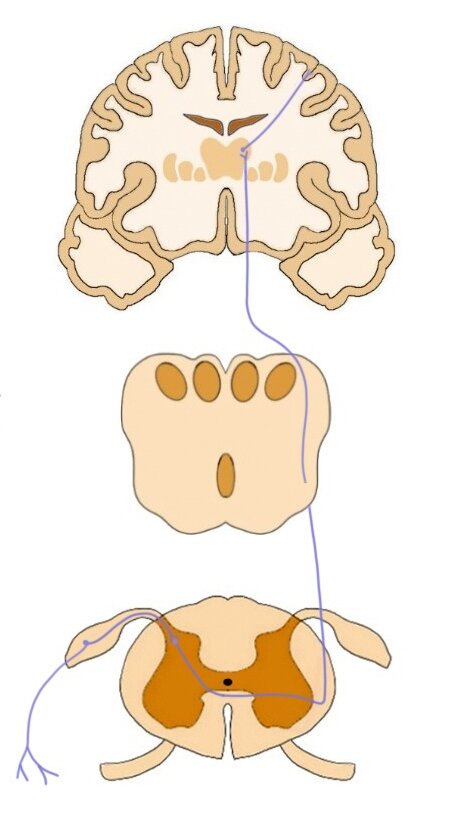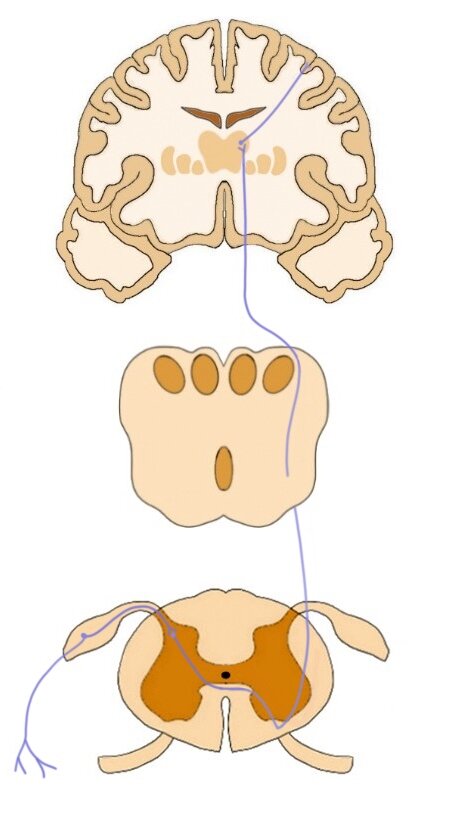Know Your Brain: Spinothalamic Tract
Where is the spinothalamic tract?
The spinothalamic tract is a collection of neurons that carries information to the brain about pain, temperature, itch, and general or light touch sensations. The pathway starts with sensory neurons that synapse in the dorsal horn of the spinal cord. Next, neurons extend from the dorsal horn and decussate, or cross over to the other side of the spinal cord, before traveling up the spinal cord, through the brainstem, and to the thalamus. These neurons synapse with neurons in the thalamus, which then carry the information to the somatosensory cortex. See below for more details on the pathway of the spinothalamic tract.
What is the spinothalamic tract and what does it do?
The spinothalamic tract actually consists of two pathways that are distinct in function: the anterior spinothalamic tract and the lateral spinothalamic tract.
Lateral spinothalamic tract

The lateral spinothalamic tract is the main pathway for carrying information about pain and temperature from the body to the brain. It is also thought to carry information about itch.
Sensations that are carried by the lateral spinothalamic tract begin with receptors such as nociceptors, which detect painful sensations, or thermoreceptors, which detect changes in temperature. These receptors pass a signal to the initial neurons of the spinothalamic tract, which transmit the signal to the spinal cord. Here, the neurons briefly either ascend or descend as part of a tract called Lissauer’s tract before synapsing on neurons in the dorsal horn of the spinal cord that belong to cell groups like the nucleus proprius or substantia gelatinosa; the latter is an important area for the modulation of pain signals.
The secondary neurons in the lateral spinothalamic tract cross over to the other side of the spinal cord and then ascend in the spinal cord, through the brainstem, and to the ventral posterolateral (VPL) nucleus in the thalamus. Because this pathway travels in the anterolateral portion of the spinal cord and brainstem, it is often referred to as the anterolateral system. In the thalamus, spinothalamic neurons synapse on cells that will carry the sensory information to the primary somatosensory cortex, which is the main processing area for sensations from the body.
Anterior spinothalamic tract

The anterior spinothalamic tract (aka ventral spinothalamic tract) carries general touch or light touch sensations from the body. This includes touch sensations that don’t involve pressure, such as the stroking of hair or air lightly blowing on the skin.
These sensations begin with sensory receptors in the skin, which pass a signal onto neurons that travel to the spinal cord. In the spinal cord, these neurons give rise to ascending and descending branches that synapse on neurons in the dorsal horn of the spinal cord. Secondary neurons arise from the nucleus proprius in the dorsal horn, cross over to the other side of the spinal cord, and ascend to the thalamus near the lateral spinothalamic tract. From there, the information is carried on to the somatosensory cortex.
Damage to the spinothalamic tract
A spinal cord injury that involves the spinothalamic tract can lead to distinctive sensory deficits. Because neurons in the tract cross over to the other side of the spinal cord before traveling up to the brain, they are carrying information from the opposite side of the body. Thus, if there is damage to one side of the spinal cord, it can cause a loss of pain, temperature, and light touch sensations on the side of the body opposite from where the damage occurred.
References:
Augustine JR. Human Neuroanatomy. 2nd edition. Hoboken, New Jersey: Wiley & Sons, Inc.; 2017.


